A quite powerful Italian protected cruiser
Piemonte was designed at the request of the Italian government, which wanted to strengthen the Regia Marina in the event of a new war against Austria. The order was placed at the world-renowned Armstrong-Elswick shipyard. Chief Engineer Philip Watts took the opportunity to propose the Italian commission a new configuration, giving the ship much larger artillery than the Dogali (ordered three years earlier at the same shipyard). The Piemonte will combined in fact two world premiere: To be the first armed entirely with quick-firing (QF) guns and the fastest cruiser worldwide. However later in her carrer, it appeared the Piemonte was unstable and thus her armament was drastically reduced. She served in the Italo-Turkish war of 1912 with distinction and served as an escort during WW1.
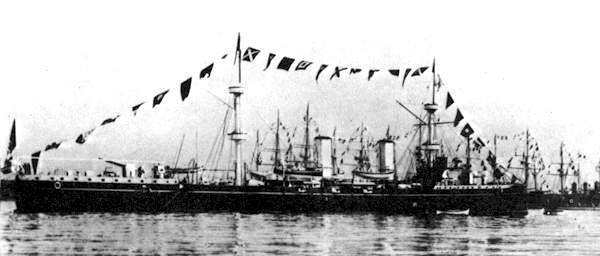
Regia Marina’s Piemonte during a naval review
About the Dogali (1885)
This protected cruiser was designed in 1884 by William Henry White and built the next year at the Armstrong Whitworth shipyard at Elswick. She was the first warship equipped with triple-expansion engines and thus became the fastest cruiser in the world at 17.68 knots (32.74 km/h; 20.35 mph). She was orginally ordered for Greece and carried a potent armament for her 76m long and 2000 tons:
six 152 mm (6.0 in) guns, nine QF mm (2.2 in) guns, six Gatling guns and four 356 mm (14.0 in) torpedo tubes. She was the first ship also to use these Pattern M guns manufactured by Armstrong Whitworth, weighing 2 t (2.0 long tons; 2.2 short tons) apiece. These brand new 32 caliber cannons mounted in sponsons were fitted in 1887, called by the Italians Cannone 152/32 Modello 1887. With these, the Dogali pounded the Boxer rebellion. Each shell weighted 45.3 kg (100 lb), had a muzzle speed of 605 m/s (1,980 ft/s) and compised a Sseparate loading 8.8 kg (19 lb) bagged ballistite charge and projectile. The Dogali was later resold in January 1908 to the Uruguayan government and renamed 25 de Agosto. She served until 1932. That’s why she’s not registered on the WW1 Italian section (yet).
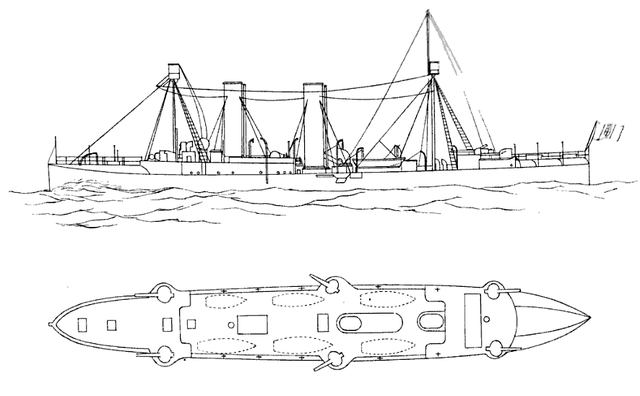
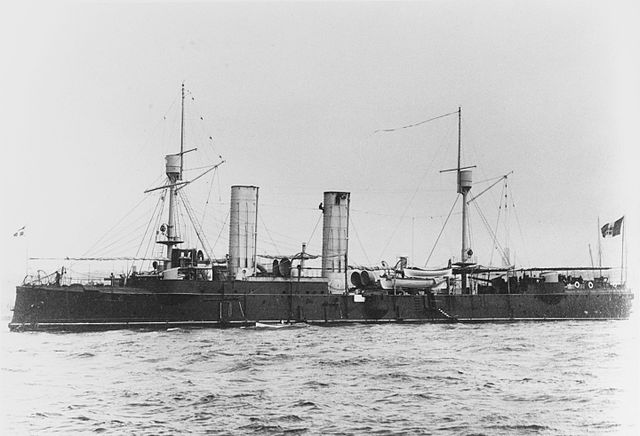
The previous Italian British-built Cruiser Dogali (1885). Already powerfully armed, she was also the first with triple expansion engines and therefore became the fastedt cruiser in the world at that time. But with the next ship, William Henry White promised to out-do himself.
Design of the Piemonte
They were characterized by two heavy military masts and had also a partial double bottom while the large sponsons extended down to 30,5 cm of the water, and were quite wet while her freeboard was only 2.51 m or 8 feet 3 inches on standard load andup to 2m or 6 feet 9 inches deep. She had her six 6-inch L/40 guns in single mounts, one forward and one aft, two on each broadside abreast of the masts mounted in sponsons to allow ahead and astern firing (90° traverse). Secondary battery comprised six 4.7-inch (120 mm) L/40 guns in single mounts. Three were placed on each side, alternating with the 15 cm guns. Tertiary armament comprised ten light quick-firing 57-millimeter (2.2 in) 6-pounder Hotchkiss L/40 guns, but also six 37-millimeter (1.5 in) 1-pounder Hotchkiss L/20 guns, and four 10-millimetre (0.39 in) Maxim machine guns to deal with torpedo boats. Four 1-pounder and the machine guns were all mounted in the military masts for better spotting and traverse. Later they were deposed on the decks and superstructures as her military masts were replaced by light pole masts. For close-quarters she had three 14-inch (356 mm) torpedo tubes, mounted in the bow and the broadside in rotating mounts.
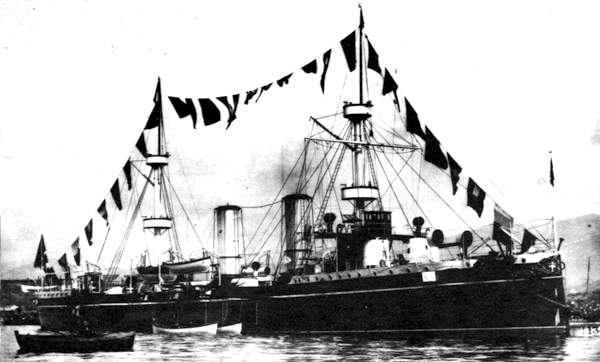
But the optimism of this armament harmed her stability and was reduced in 1891. She kept 2 x 152 mm, 10 x 120 mm, and 6 x 37 mm. In 1913, the 152 mm cannons were removed and the light armament was again revised. Her general protection was good but not complete. She lacked in particular a double-bottomed hull, and ballasts were missing at the level of the engine rooms. Armor protection consisted indeed of a sloped deck about 1 inch (25 mm) (vertical surfaces) up to 3 inches (76 mm) on sloped plates. The conning tower was 3-in thick (76 mm) too nd the gun’s shields were all protected by 4.5 inches (110 mm) of armour. So no protection reached the caliber on board (6 in), but this was considered OK for a protected cruiser. Only Armoured ones had the protection equivalent to match their own calibers.
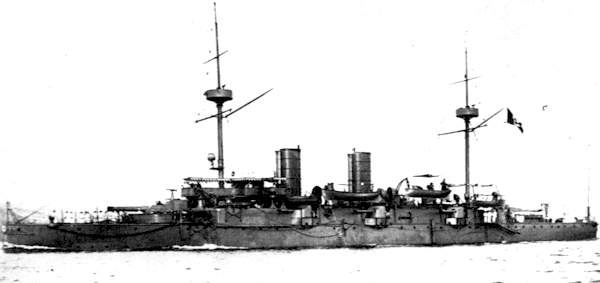
The cruiser Piemonte in the 1890s
However this was by her speed she made headlines, the italians indeed being the first to introduce the world’s fastest cruiser. She was indeed powered by two 4-cylinder Humphrys, Tennant vertical triple-expansion steam engines with a 27 inches (690 mm) stroke and 36 inches (910 mm) bore cylinder, and also 55 inches (1,400 mm) and 60 inches (1,500 mm) for the second and third level. The low-pressure cylinders were split in two for smoother running, a complete novelty at that time. Steam came from four double-ended Scotch marine boilers. Working pressure was 155 psi (1,069 kPa; 11 kgf/cm2) their exhausts being trunked into a pair amidships. Maximum output was 12,000 indicated horsepower (8,900 kW) as designed, for a service top speed of 20.4 knots (37.8 km/h; 23.5 mph). But during her sea trials in May 1889 and using forced draught the output came up to 12,600 ihp (9,400 kW) for 22.3 knots (41.3 km/h; 25.7 mph), the fastest speed on record for such category of ship.

The Piemonte in 1914
Carrer of the Piemonte
The Piemonte was one of the oldest cruisers in service in the Italian Navy in 1914: She has been started in 1887 and completed in 1889. At the start of her career she participated to the annual fleet maneuvers in the First Squadron, made manoeuvers in the Tyrrhenian Sea, returned in drydock to solve her stability issues (armament removal, new masts, etc), and later served in the Red Sea and the Indian Ocean, and in mid-1896 intervened in Brazil to protect Italia interests. She was later modernized and sent in 1901 to the East Asian station. She sailed to Nagasaki, Japan in 1902,
then to the British colony at Weihaiwei, and was an observation vessel during the 1905 Russo-Japanese war, landing some infantry ro reinforce Seoul’s Italian embassy own guards. In 1908 she was back home, and served as a flagship of the torpedo flotilla: Seventeen destroyers, fifty 1st/2nd class torpedo boats.
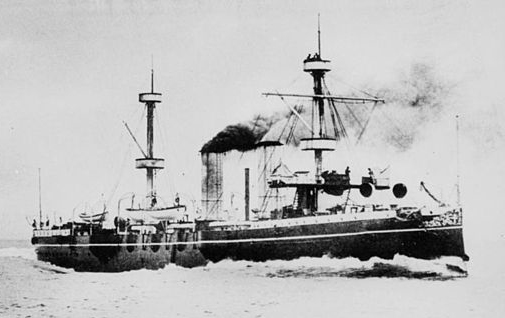
Her hour of glory came in 1911, after a series of brief engagements against the Turkish Fleet, on January 7, 1912, off Kunfida in the Red Sea, she battered and destroyed an entire Turkish flotilla of no less than 8 Turkish gunboats and one armed yacht: This was the Battle of Kunfuda Bay. She also shelled and blockade the city of Al Hudaydah on 26 January, and Al Hudaydah during the 12 August attack. Alessandro Guidoni once proposed in 1912 to convert her into a regular planes and seaplane carrier. This never took place. She had no other opportunities so favorable during the great war where she served mainly as escort for the 2nd fleet based in Brindisi. She waited idle for a possible Austro-Hungarian sortie, was affected to Salonica, Greece as part of the Anglo-French Levant Squadron. She was stricken and disarmed in 1920.
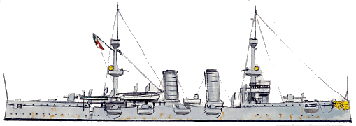
Illustration of the Piemonte in ww1 (1/750) by the author

Line Drawing of the Piemonte – The blueprints.
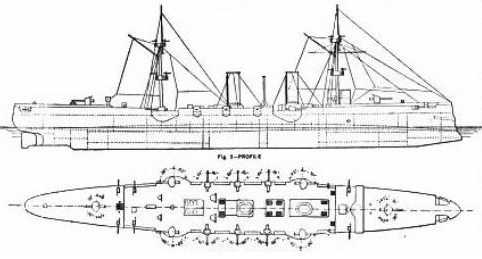
Another Line Drawing of the Piemonte.
Sources/Readmore
https://en.wikipedia.org/wiki/Italian_cruiser_Dogali
https://en.wikipedia.org/wiki/Italian_cruiser_Piemonte
http://www.fr.naval-encyclopedia.com/1ere-guerre-mondiale/marine-italienne1914.php#crois
https://it.wikipedia.org/wiki/Piemonte_(ariete_torpediniere)
http://russiannavy.net/militaryPhotos/engineering/italian/
Conways all the world’s fighting ships 1860-1905


 Latest Facebook Entry -
Latest Facebook Entry -  X(Tweeter) Naval Encyclopedia's deck archive
X(Tweeter) Naval Encyclopedia's deck archive Instagram (@navalencyc)
Instagram (@navalencyc)





 French Navy
French Navy Royal Navy
Royal Navy Russian Navy
Russian Navy Armada Espanola
Armada Espanola Austrian Navy
Austrian Navy K.u.K. Kriegsmarine
K.u.K. Kriegsmarine Dansk Marine
Dansk Marine Nautiko Hellenon
Nautiko Hellenon Koninklije Marine 1870
Koninklije Marine 1870 Marinha do Brasil
Marinha do Brasil Osmanlı Donanması
Osmanlı Donanması Marina Do Peru
Marina Do Peru Marinha do Portugal
Marinha do Portugal Regia Marina 1870
Regia Marina 1870 Nihhon Kaigun 1870
Nihhon Kaigun 1870 Preußische Marine 1870
Preußische Marine 1870 Russkiy Flot 1870
Russkiy Flot 1870 Svenska marinen
Svenska marinen Søværnet
Søværnet Union Navy
Union Navy Confederate Navy
Confederate Navy Armada de Argentina
Armada de Argentina Imperial Chinese Navy
Imperial Chinese Navy Marinha do Portugal
Marinha do Portugal Mexico
Mexico Kaiserliche Marine
Kaiserliche Marine 1898 US Navy
1898 US Navy Sovietskiy Flot
Sovietskiy Flot Royal Canadian Navy
Royal Canadian Navy Royal Australian Navy
Royal Australian Navy RNZN Fleet
RNZN Fleet Chinese Navy 1937
Chinese Navy 1937 Kriegsmarine
Kriegsmarine Chilean Navy
Chilean Navy Danish Navy
Danish Navy Finnish Navy
Finnish Navy Hellenic Navy
Hellenic Navy Polish Navy
Polish Navy Romanian Navy
Romanian Navy Turkish Navy
Turkish Navy Royal Yugoslav Navy
Royal Yugoslav Navy Royal Thai Navy
Royal Thai Navy Minor Navies
Minor Navies Albania
Albania Austria
Austria Belgium
Belgium Columbia
Columbia Costa Rica
Costa Rica Cuba
Cuba Czechoslovakia
Czechoslovakia Dominican Republic
Dominican Republic Haiti
Haiti Hungary
Hungary Honduras
Honduras Estonia
Estonia Iceland
Iceland Eire
Eire Equador
Equador Iran
Iran Iraq
Iraq Latvia
Latvia Liberia
Liberia Lithuania
Lithuania Mandchukuo
Mandchukuo Morocco
Morocco Nicaragua
Nicaragua Persia
Persia San Salvador
San Salvador Sarawak
Sarawak Uruguay
Uruguay Venezuela
Venezuela Zanzibar
Zanzibar Warsaw Pact Navies
Warsaw Pact Navies Bulgaria
Bulgaria Hungary
Hungary

 Bundesmarine
Bundesmarine Dutch Navy
Dutch Navy Hellenic Navy
Hellenic Navy Marina Militare
Marina Militare Yugoslav Navy
Yugoslav Navy Chinese Navy
Chinese Navy Indian Navy
Indian Navy Indonesian Navy
Indonesian Navy JMSDF
JMSDF North Korean Navy
North Korean Navy Pakistani Navy
Pakistani Navy Philippines Navy
Philippines Navy ROKN
ROKN Rep. of Singapore Navy
Rep. of Singapore Navy Taiwanese Navy
Taiwanese Navy IDF Navy
IDF Navy Saudi Navy
Saudi Navy Royal New Zealand Navy
Royal New Zealand Navy Egyptian Navy
Egyptian Navy South African Navy
South African Navy






























 Ukrainian Navy
Ukrainian Navy dbodesign
dbodesign